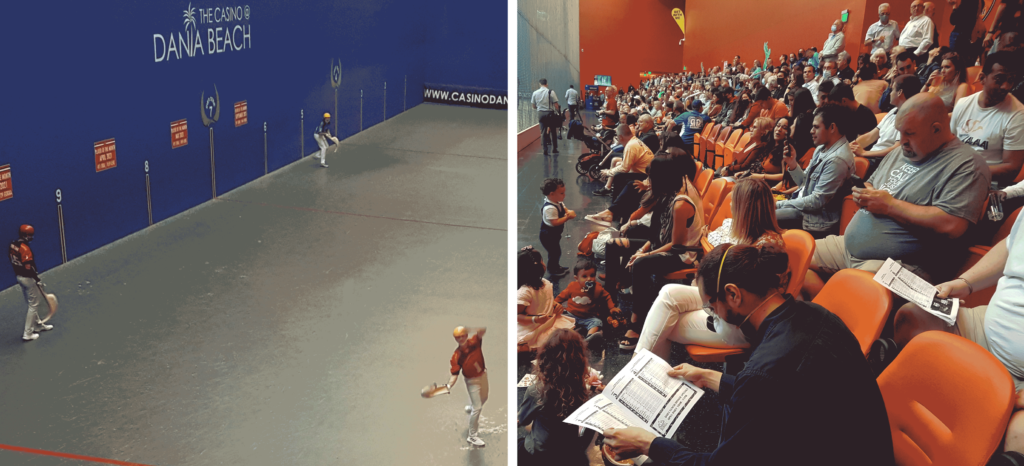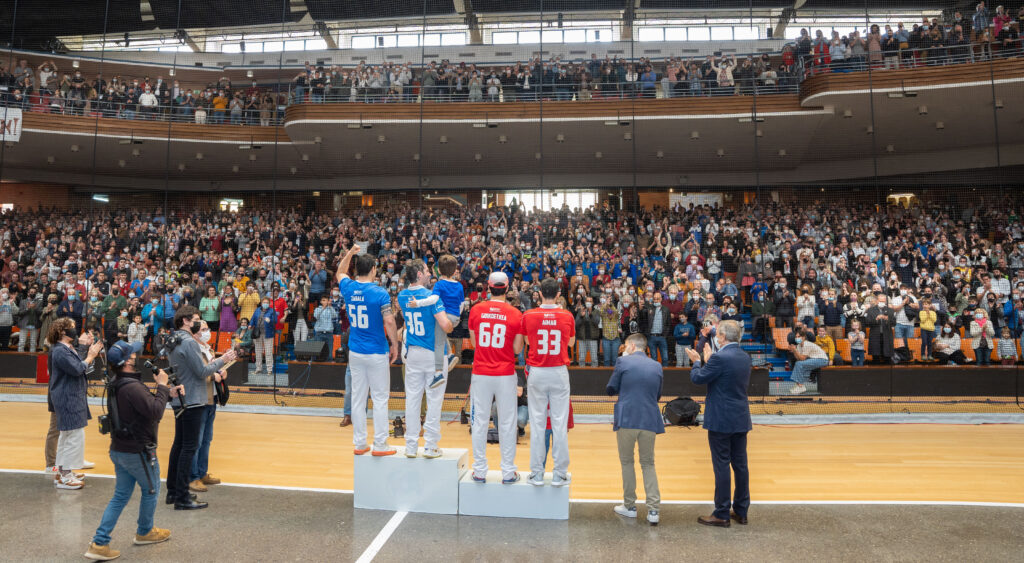Juan Inazio Zulaika (born in Andoain in 1956) was a Jai-Alai player who made his professional debut at the age of 14 in Zaragoza (Spain). Then he played in Milan (Italy) and Barcelona (Catalonia), before crossing the pond and playing for 15 years in the USA, 8 in Florida and 6 in Connecticut. But above all, he is known today as the most important intellectual reference when it comes to analyzing the past, present and future of the most widely spread modality of Basque pelota internationally. He writes his stories and thoughts on his very successful trilingual blog, and is looked to by all those who want to know something about Jai-Alai. He has also written several times in basquetribune.
On November 28, 2021 the last Jai-Alai fronton that remained open in the USA, Florida’s Dania, closed its doors. Zulaika was there living the moment and sharing his stories with all the faithful followers of this spectacular sport. On his return from his two-month stay, we talked to him and collected his impressions.

Basquetribune- How was your experience during those weeks in Florida?
J.I. Zulaika- It was a two-month period full of emotions. Full of impressive symbolism, because we witnessed the felling of the last tree in a forest that was once flourishing. It was the end of an era. In addition, in my case, there was an added factor, because my son Ion was part of that final team, the last group of Jai-Alai players who were still playing in the USA after many decades.
Still?
Yes, there will be reopenings by a group of Argentine businessmen, although it won’t be quite like it has been until now. Instead, the format will be short-term tournaments. This is feasible, because since everything has been economically liquidated, they have a free hand to start from scratch without the pressure of players or unions. It’s about imitating the tennis model to some extent. They also want to take advantage of the prime months of Canadian tourism.
How many people used to come to the fronton in this last stage?
The average attendance was around 100 people, with six weekly sessions and a roster of 26 pelotaris (players). Logically, the final days there was saw a considerable increase in public, like people coming to a funeral. People who for decades have lived the Jai-Alai experience and wanted to be present for the farewell.
The ending, on the other hand, did not have an excessive echo in the media in Florida and the United States, except for some isolated reports.
In the heyday, the numbers were different…
That’s right, there were 16 frontons open simultaneously throughout the country, with approximately 600 ball players. Most in Florida, but also in Connecticut and Rhode Island. By that time the Nevada ones were closed. In all there have been about 3,000 players in the USA, 4,000 worldwide, who sometimes also earned a lot of money.
Since the nineteenth century, when Basque pelotaris began to go to Argentina to play ball and expanded throughout the world, it is the first time that there is no professional fronton open outside the Basque homeland. Some may cite the new Magic City modality in Miami with a glass enclosed space, but that is another thing.
The reopening of the Mexico City fronton has not been successful either and it seems that it was more linked to a real estate venture movement. In addition, Mexican society has changed a lot. As in other parts of the world, those high rollers have disappeared. Closures in Italy, Cuba, the Philippines, Brazil, Egypt and many other countries date further back in time.

What was the reason for this decline in the US?
The lack of betting has been what has killed Jai-Alai, but not only in the US. This has happened all over the world, outside the original geographical scope of Basque pelota. Betting has been the blood flow for Jai-Alai and once it bled out, the circle has been cut off and confined to Euskal Herria (the Basque Country). Other more modern betting modalities have been imposed, like the ones used with cell phone applications. And the privilege that Jai-Alai once knew (along with horse racetracks and dog racing) when it came to getting licenses for betting has also disappeared.
Does this mean that as a sport it has not been attractive?
No, it has not been attractive enough to sustain itself in the USA. From the beginning it was framed in a purely industrial and betting field, the Pari-Mutuel, along with dog racing and horse racetracks, each of them with their respective seasons. They were the only authorized activities in Florida, until the authorities decided that casinos would not need to maintain such activities. That political decision was the final nail to the coffin.
Attracting Jai-Alai as a sport was never the main goal. As a sport, it was also well liked, but all of this had less importance than the world of betting. There is an interesting story about Leonard Wood, who was general governor in Cuba from 1898-1902. This man fell in love with this Basque sport and predicted a great future for it in the world, like other sports that had been exported from Europe, such as tennis or golf. But it’s clear that it wasn’t successful.
If everything is based on the betting business, it’s almost impossible for a sport to succeed as such. For example, if children under 18 are not allowed to enter the frontons, as was the case in the US, it is very difficult to transmit the hobby on to future generations and to share it in the family environment. Without young people who join naturally, a sport cannot succeed as such.
A question that many people are asking is what influence did the 1988 US pelotari strike that lasted three years have on this decline?
That strike accelerated the process of the decline, but it was already irreversible. There have always been strikes in other sports, but in sports more deeply rooted in society which can withstand the blow. In sports that are in the extreme minority, it’s more difficult to recover from it.
On the other hand, it seems that the problem of Basque pelota is more general, which does not only affect Jai-Alai. Other professional modalities such as pala or remonte are in a permanent state of agony. Only hand ball holds up relatively well, although it also has its problems.
The truth is that professional ball is managing to stay alive on Basque soil largely because there is governmental financial aid, like alms. There is also a strong cultural identity and a number of romantics who support it. But the harsh reality is that sociologically and economically there are no objective reasons for its survival, like what happened in Dania but for other reasons. The reality is that most pelotaris of these modalities can no longer live from the sport with decent economic conditions.
Can one of the problems be the excessive dispersion of different modalities in Basque pelota?
Of course, the existence of so many modalities in such a small market is something that doesn’t help. We’re not talking about a nation of many million inhabitants where there is room for multiple professional sports and a lot of private money involved in them. Professional ball is a subsidized market, largely dependent on public money, including the handball modality. This fact, combined with dependence on public money, greatly slows down innovation, creativity and market expansion.

However, it seems that ETB (Basque public television) has already made innovations, in its broadcasts for example.
Yes, but despite this, there is a certain accommodation: they do relatively well with their audiences, period. The real fact is that the attempts to expand handball to other markets have not caught on. The media chef and businessman Karlos Arguiñano tried through Spanish private television, but in the end, he has been confined to his traditional geographical scope. His effort hasn’t been successful. Nor has it been possible to penetrate strongly into social networks and other platforms that hook young people.
I already mentioned before that I don’t consider the invention of Magic City Jai-Alai of Miami as Basque pelota in the strict sense, but there is one thing that I do value in its creators: their capacity for innovation.
But does this invention have a future?
It seems to. As another modality, a new version of traditional Jai-Alai is growing in terms of media presence. The managers running Magic City have been through the traditional Jai-Alai experience. They believe in what they are doing. New laws in other states regarding permissiveness allow them to open the range for new online bettors to use new applications and ways of betting. Their idea is to expand these types of frontons without limits. Magic City is an innovative type of management adapting to new times. It’s very interesting what they’re doing. So far, they employ only pelotaris with US passports.
After the Dania fronton closure, an unexpected phenomenon has taken place in the Basque Country. Specifically in Gernika, the Winter Series tournament has been incredibly successful. Can we speak of a certain renaissance?
Rebirth, with reservations. The Winter Series tournament has been an unexpected success. It has exceeded all expectations. The presence of young people has been a striking factor. Several factors have come together that serve to explain the success. ETB has given a huge effort to the promotion of the tournament, taking advantage of perfect timing. There was a breeding ground based on the emotions stirred up from the Dania fronton closing. The advertising campaign was the best of the best for relaunching a product. The local talent, the company Gernika Jai-Alai Professional, has been organizing Jai-Alai events in Gernika for seven years with admirable know-how. They offer reasonable box-office prices at 5 euros a ticket, except for the day of the finals at 15 euros. This way, they’ve been able to connect with young people.
The question remains whether we’re facing a local phenomenon or one that can be reproduced in other places like San Sebastian, Markina or Hondarribia.
When talking about rebirth, the fact that there isn’t a coordinated network when it comes to organizing tournaments in different geographical areas is a burden when it comes to relaunching the specialty. There are the promoters of Hegoalde (Southern Basque Country), Iparralde (Northern Basque Country) and Florida. And the World Council and the International Federation of Basque Pelota are acting on their own without a common calendar.

There are some aspects that are working in Jai-Alai, such as the summer seasons in Iparralde.
Yes, it’s a model designed primarily for tourism. Since betting is prohibited in France, they have approached it that way. These are months in which frontons are filled, even if the spectators are not familiar with the sport. In the south, in Hondarribia, they have imitated the experience to some extent, but the big problem is the lack of young people in the stands.
To finish, what does the future hold for Jai-Alai?
There are two possibilities. The first is using the current management model. One that, despite the fact that the forces are dispersed, has a stable and adequate calendar so that a good number of pelotaris, 15 or so, can participate in different tournaments. Always with governmental backing.
The second possibility is with a new entity entering the scene, knowing how to bring together all forces. In this case, expectations would have to change. The potential of the specialty, its international vocation, would once again become a reality opening the door to new markets.
Editor’s Note: The term Jai-Alai means joyful feast in Basque. It was a creation of the writer Serafín Baroja to baptize a new fronton to play Basque pelota in San Sebastian in 1887. The name was extended to new facilities that were being built. At the time the term was referring to the space, not the sport. But later, especially outside the Basque Country, its meaning has been transformed and the term has been used almost as a synonym for one of its modalities, the most international of them and the the subject of this interview.


Tried to save jaialai for the kids 20 years ago with Inigo Kalzakorta,a thief.
Had a chance to save jaialai but Inigo Kalzakorta failed.
Dear Mr. Irazabal,
I came accross your article about Jai Alai. I was an amateur pelotari in Manila, Philippines during my younger days. I could honestly say that this game is still very much love, by many, in the Philippines. I now live in the USA, but saw a video on youtube a jai alai tournament (about 2 years old) being played in Cagayan, Philippines fronton. I would love this sport to be revived also. Could this place in the Philippines be the one to start? I could send you the youtube link on the tournament if needed.
Thank you.
V/R,
Art Aloba